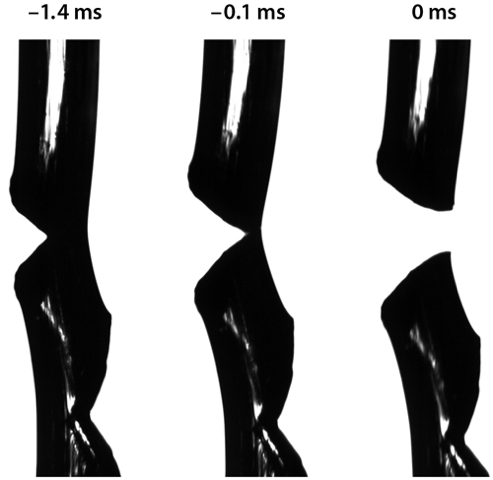August 17, 2016 report
High speed experiments show what happens when polymer liquids crack

A small team of researchers with the Technical University of Denmark and Drexel University in the U.S. has found that it is possible to cause a liquid to crack under the right conditions. In their paper published in the journal Physical Review Letters, the team describes their experiments, what they learned and outline ways in which their findings may be suitable for use in industrial applications in the future.
A lot of study has been done regarding cracks in solid materials to learn what causes them, how to prevent them, etc. Doing so has helped to create materials that better suit our purposes and which are, in some cases, safer for us to use, e.g. for airplane components. But up till now, little work has been done to study cracks in liquids, in part because it would seem logical to assume that they don't exist. But as the researchers with this new effort found, they not only do exist, but take on many of the same properties as cracks that occur and propagate through solid materials.
To learn more about cracks in a liquid, the researchers used polymers that exhibited liquid properties at room temperature, e.g. they flowed downhill when given enough time. To find out if they crack, the team put them into tubes and tried pulling them apart, all the while filming the action with a high-speed camera. The video revealed that when enough force was applied very quickly, cracks did, indeed, appear as the material was stretched to its breaking point and that those cracks also propagated through the material in ways very similar to cracks found in solid materials. But they found one major difference—in the polymers, more than one crack appeared at the same time. This, the team suggests, indicates that initial crack formation in a liquid is not based on "the weakest link," as is most often the case with solids. Instead, it appears that such cracks are based on the dynamic state of the material, which further suggests that such cracking is reproducible. Additionally, they found that the liquids were able to sustain large amounts of strain relative to their size—in some cases over 25 percent.
More information: Qian Huang et al. Multiple Cracks Propagate Simultaneously in Polymer Liquids in Tension, Physical Review Letters (2016). DOI: 10.1103/PhysRevLett.117.087801
Journal information: Physical Review Letters
© 2016 Phys.org



















